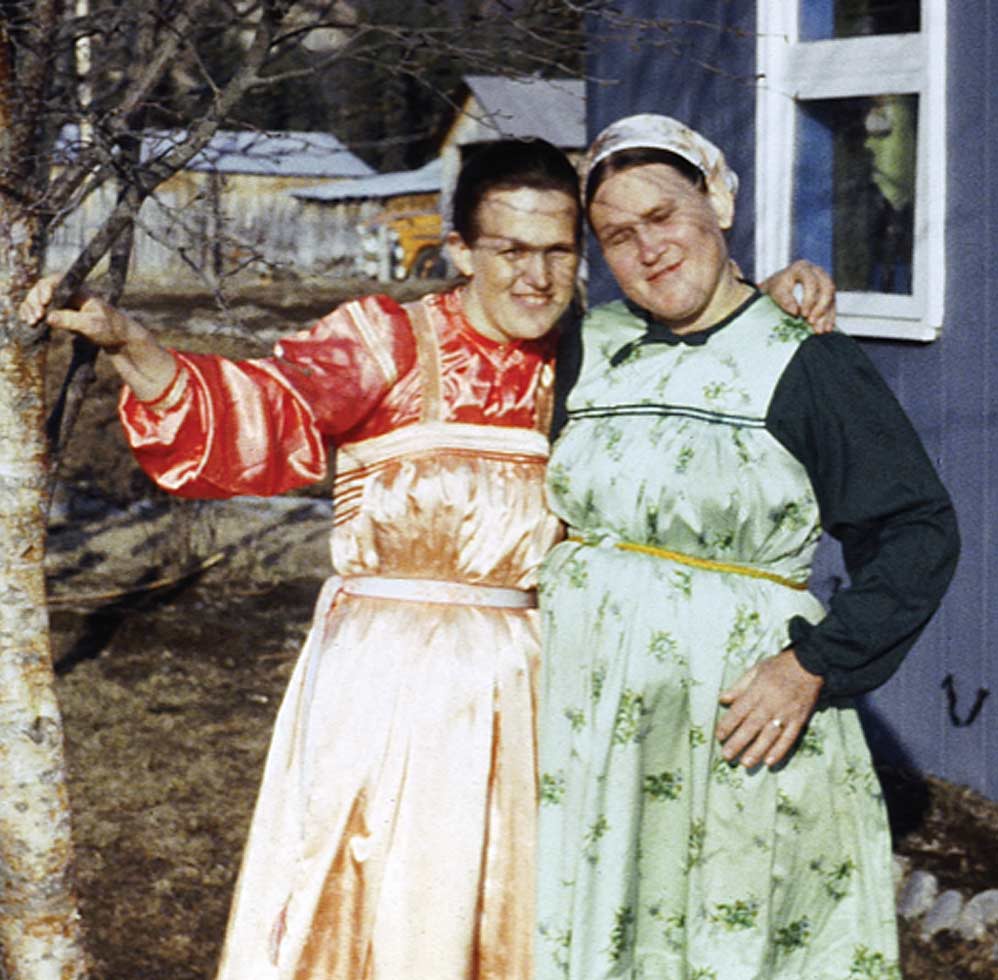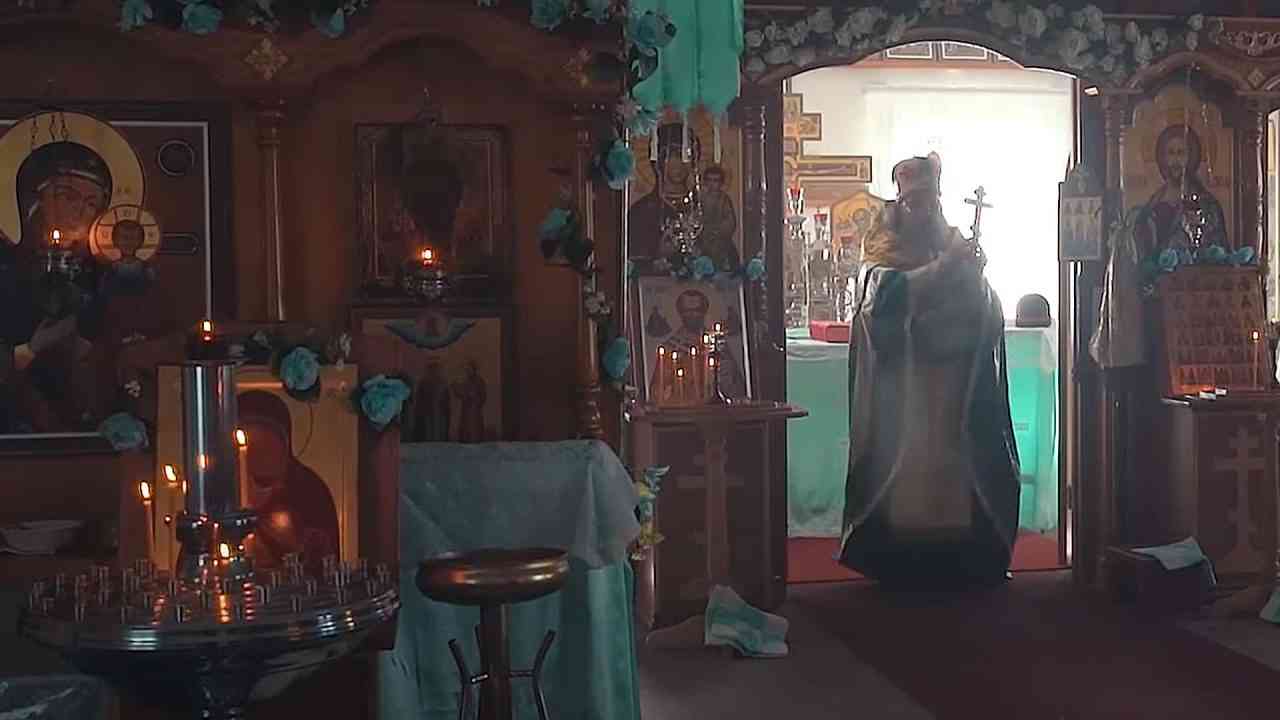
Russian Old Believer language and stories reflect their life in the North, the picturesque landscapes and their economic contacts with non-Russian nationalities.

Some elements of the Siberian way of life, however, and vocabulary persist only in the descriptions of material culture. Poetry, reflecting the spiritual life of the epic heroes, remains unchanged and is preserved as a precious relic, even when words and expressions have lost their relation to former life situations and have become outdated.
North American Old Believers speak Russian at home and in most workplaces. Although only a few Alaskan Old Believers were born in Russia or in Russian-speaking communities abroad (i.e., China, Japan, South America), the Russian language is very much alive.
Given the size of Russian communities in Oregon and Alaska, there is ample opportunity for Russian speakers to form groups for contract work outside of their villages, reducing the need to learn English as a second language. Living in neighborhood clusters in rural Alaska, there is little need for members, especially women who remain at home and have little interaction with the outside world, to speak English. Parents encourage their children to speak Russian at home and to have minimal interaction with English-speaking outsiders, so there is limited opportunity to practice English at home.
During an interview, my assistant, Miriam Lancaster, observed and recorded two children learning Russian and English at home:
“As we were putting the puzzles together and coloring, I asked two children the colors of various things. The older child would always respond in perfect English. When I asked the younger child, he just smiled and the older would whisper the word in English into the younger child’s ear. The younger would smile bigger and say the color in English. I told the children’s mother that I was surprised that the older child could speak English so well since he wasn’t old enough to be in school. The mother said she only speaks Russian to him at home because she’s afraid he will forget their language. She said the only place he hears English is on TV from “Sesame Street” and “Mr. Rogers.” It also surprised me that the child knew to speak only English to me. The older child and I spoke quite a lot and he never mixed a Russian word with English. When speaking to everyone else in the room, he spoke Russian.”

Today, anyone over the age of 70 who has not attended public school and has had limited exposure to English-speaking people, predominantly speaks Russian. Their conversational Russian is quite fluent, with a relatively extensive vocabulary, similar to the language of Siberian peasants with South-European Russian dialect. Since the language of groups from Turkey and Romania includes many Ukrainian, Turkish and Polish words as well as East European dialectic variations, mixed with a common English vocabulary, it is sometimes difficult for researchers trained in contemporary Russian language to understand or identify the Old Believer dialect.
Church Slavonic is used for religious services and the young learn to read and chant from their parents and older siblings. It is considered prestigious for Old Believers to read books in Church Slavonic during worship and religious holidays and parents always admire such efforts.
Despite heavy Americanization in North America, the Russian language, as a symbol representing an idea, national identity or quality of life, is the channel by which Old Believers communicate beliefs and attitudes to children, clarifying the place they are to take as adults in the community and the world.
Early marriage and full-time work are thought to have advantages; they keep the young engaged with adult responsibilities.
While the law of the dominant culture, whether in the U.S., the former Soviet Union or in today’s Russia, has always required the young to attend public schools, parents have been somewhat apathetic about enrolling their children. In fact, many Old Believers still have an uneasy feeling of inferiority in matters of ecclesiastic learning.
There are frequent religious holidays when children, as well as their parents, attend church in the early morning hours, conflicting with the school schedule. The school schedule in Nikolaevsk, Voznesenka and Berezovka villages in Alaska, however, is adjusted according to religious demands and practices of the community, since most students are Old Believers.
Twelve greatly significant Old Believer Religious Holy Days are included in the school calendar, in addition to the regular school holiday/vacation days. The Old Believers’ twelve Holy Days during the school year in Nikolaevsk, Alaska are: 8/19 (Transfiguration of Christ); 8/28 (Assumption of the Mother of God); 9/11 (Beheading of St. John the Baptist); 10/9 (St. John the Theologian); 10/14 (Protection of Mother of God); 12/4 (Presentation of Mother of God); 12/19 (St. Nicholas of Wonderworker); 1/7 (Birth of Christ); 1/19(The Eve of Epiphany); 5/13 (Mid-Pentecost Wednesday); 5/21 (St. John the Theologian); and 5/28 (Holy Ascension).
The total enrollment at the Nikolaevsk state-operated K-12 school is about 140 students, between 110–120 are Russian Old Believers. There are two to four Old Believers teachers who teach Russian language, and the school board is formed primarily from Old Believers who control school curriculum, requirements and, to some degree, the school’s internal environment.
Today, a shortage of job opportunities in the villages has resulted in many Old Believers leaving their traditional communities to move to urban areas of Alaska.
Older children are often kept at home to look after younger siblings, with large nuclear families commonly having 6-12 children. Many Old Believer parents are apprehensive about the exposure their children receive at school. There is outright objection to subjects they consider offensive, including some science curriculum, sex education, music, contemporary art, literature and aerobics. They also often complain that the school environment tends to weaken the disciplined behavior required of their children. Parents frequently urge teachers to be stricter with their children, encouraging them to use physical punishment when necessary.
Today, a shortage of job opportunities in the villages has resulted in many Old Believers leaving their traditional communities to move to urban areas of Alaska. Here they raise their families in predominately non-Russian speaking neighborhoods. It is common to see young Old Believer families at public recreation facilities, including swimming pools, skating rings, shopping malls and parks. Children of Old Believer families living in urban areas attend public schools as minorities, with non-Russian students, in contrast to public schools in Old Believer villages where most students are from Old Believer families.
Parents of students attending school in urban areas provide school administrators with information about traditional practices, religious restrictions and a schedule of religious holidays that must be observed by their children during the academic year. School administrators accommodate these requests with sincere understanding and respect for Old Believer culture.
ALASKA WATCHMAN DIRECT TO YOUR INBOX
Over the past 25-30 years, some Old Believers, both male and female, have received a college education or vocational training and many young have left their traditional community. However, Old Believers generally retain a characteristic Russian peasant attitude toward public education, namely that the young should learn to read, write and think so as not to be cheated by shopkeepers and hostile neighbors. Any more abstract learning is in God’s realm and should be left alone. Consequently, parents have regularly withdrawn their children from public schools after the sixth grade, at a time when the “offensive” subjects are offered and when children’s labor becomes essential to the family budget and livelihood.
Their formal education brought to a halt, children are given household responsibilities when very young, and they turn their attention to full-time adult work along with their parents. As a general rule, they achieve adulthood early and are encouraged to marry early as well. For boys, the marriage age is about 17–22, and for girls, the age is usually between 15–20.
Early marriage and full-time work are thought to have advantages; they keep the young engaged with adult responsibilities. The newlyweds frequently become parents within the first year. Thus, they have an obligation to abide by the religious rules to keep themselves in the “union,” if for no other reason than to be eligible to baptize their children. It is believed that the young will be protected from the temptations of the host cultures by occupying themselves with church and family, and in remaining self-sufficient. All of this takes time, and both causes and necessitates interaction with “one’s own kind,” preserving the hierarchy of authority and conservative social orders within the community.







2 Comments
Thank you for the insight. As a member of the Russian Orthodox Church in Fairbanks, I wasn’t aware of some of these experiences and life styles described in this article. It’s nice to now know more background information. And it’s also admirable to see a culture remain the same even with so many pressures of the modern world all around. But that’s of course why I joined the Russian Orthodox Church to begin with.
Interesting article. The old Russian way of life sounds simple and beautiful ♥️